Consolidated Portfolio: Project Management Methodologies PPMP20009
VerifiedAdded on 2020/05/28
|7
|2287
|55
Project
AI Summary
This project management portfolio, submitted as part of the PPMP20009 course, provides a comprehensive overview of project management methodologies. The portfolio explores the evolution of project management, highlighting the shift from rigid approaches to more agile and adaptive strategies. It analyzes the impact of different methodologies on stakeholders, emphasizing the importance of flexibility to meet changing project requirements and stakeholder expectations. The project also examines how organizations can leverage various methodologies to maximize profits, improve efficiency, and effectively manage resources. The student reflects on the course, emphasizing the importance of selecting appropriate project managers, building effective project teams, and choosing the right methodology to meet project and organizational goals. The portfolio incorporates references to relevant literature and includes attached portfolios as evidence to support the discussed concepts.
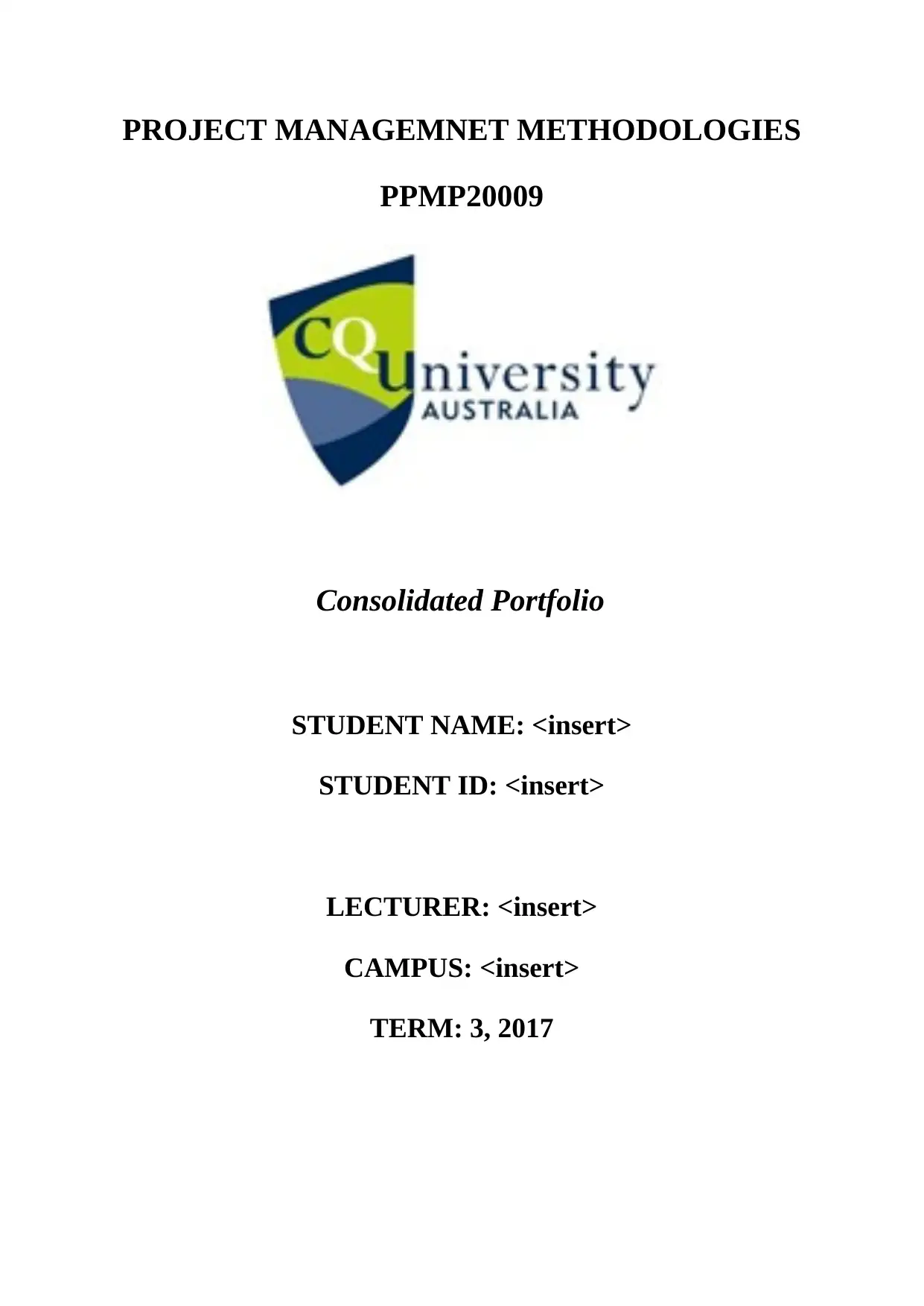
PROJECT MANAGEMNET METHODOLOGIES
PPMP20009
Consolidated Portfolio
STUDENT NAME: <insert>
STUDENT ID: <insert>
LECTURER: <insert>
CAMPUS: <insert>
TERM: 3, 2017
PPMP20009
Consolidated Portfolio
STUDENT NAME: <insert>
STUDENT ID: <insert>
LECTURER: <insert>
CAMPUS: <insert>
TERM: 3, 2017
Paraphrase This Document
Need a fresh take? Get an instant paraphrase of this document with our AI Paraphraser
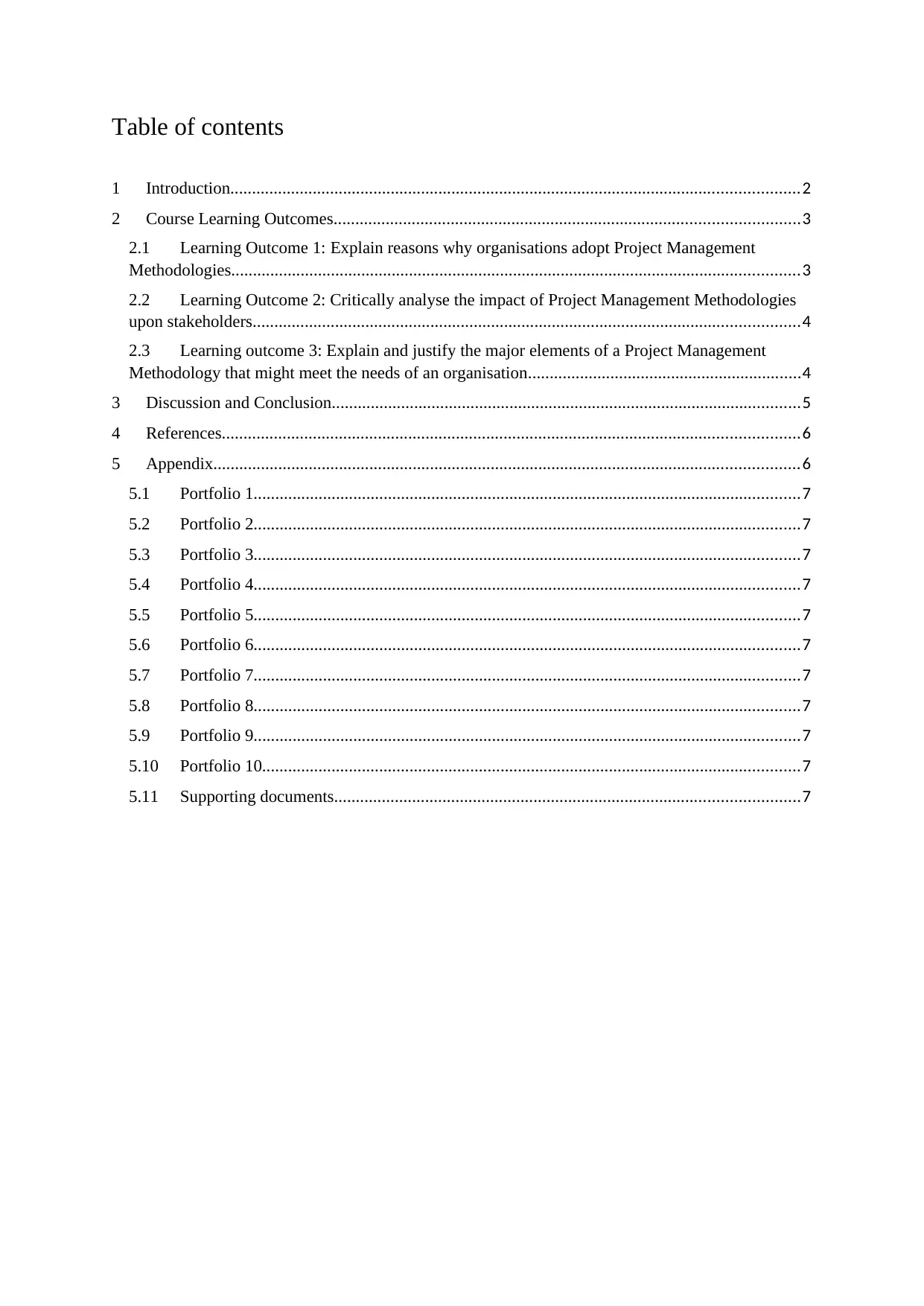
Table of contents
1 Introduction...................................................................................................................................2
2 Course Learning Outcomes...........................................................................................................3
2.1 Learning Outcome 1: Explain reasons why organisations adopt Project Management
Methodologies...................................................................................................................................3
2.2 Learning Outcome 2: Critically analyse the impact of Project Management Methodologies
upon stakeholders..............................................................................................................................4
2.3 Learning outcome 3: Explain and justify the major elements of a Project Management
Methodology that might meet the needs of an organisation...............................................................4
3 Discussion and Conclusion............................................................................................................5
4 References.....................................................................................................................................6
5 Appendix.......................................................................................................................................6
5.1 Portfolio 1..............................................................................................................................7
5.2 Portfolio 2..............................................................................................................................7
5.3 Portfolio 3..............................................................................................................................7
5.4 Portfolio 4..............................................................................................................................7
5.5 Portfolio 5..............................................................................................................................7
5.6 Portfolio 6..............................................................................................................................7
5.7 Portfolio 7..............................................................................................................................7
5.8 Portfolio 8..............................................................................................................................7
5.9 Portfolio 9..............................................................................................................................7
5.10 Portfolio 10............................................................................................................................7
5.11 Supporting documents...........................................................................................................7
1 Introduction...................................................................................................................................2
2 Course Learning Outcomes...........................................................................................................3
2.1 Learning Outcome 1: Explain reasons why organisations adopt Project Management
Methodologies...................................................................................................................................3
2.2 Learning Outcome 2: Critically analyse the impact of Project Management Methodologies
upon stakeholders..............................................................................................................................4
2.3 Learning outcome 3: Explain and justify the major elements of a Project Management
Methodology that might meet the needs of an organisation...............................................................4
3 Discussion and Conclusion............................................................................................................5
4 References.....................................................................................................................................6
5 Appendix.......................................................................................................................................6
5.1 Portfolio 1..............................................................................................................................7
5.2 Portfolio 2..............................................................................................................................7
5.3 Portfolio 3..............................................................................................................................7
5.4 Portfolio 4..............................................................................................................................7
5.5 Portfolio 5..............................................................................................................................7
5.6 Portfolio 6..............................................................................................................................7
5.7 Portfolio 7..............................................................................................................................7
5.8 Portfolio 8..............................................................................................................................7
5.9 Portfolio 9..............................................................................................................................7
5.10 Portfolio 10............................................................................................................................7
5.11 Supporting documents...........................................................................................................7
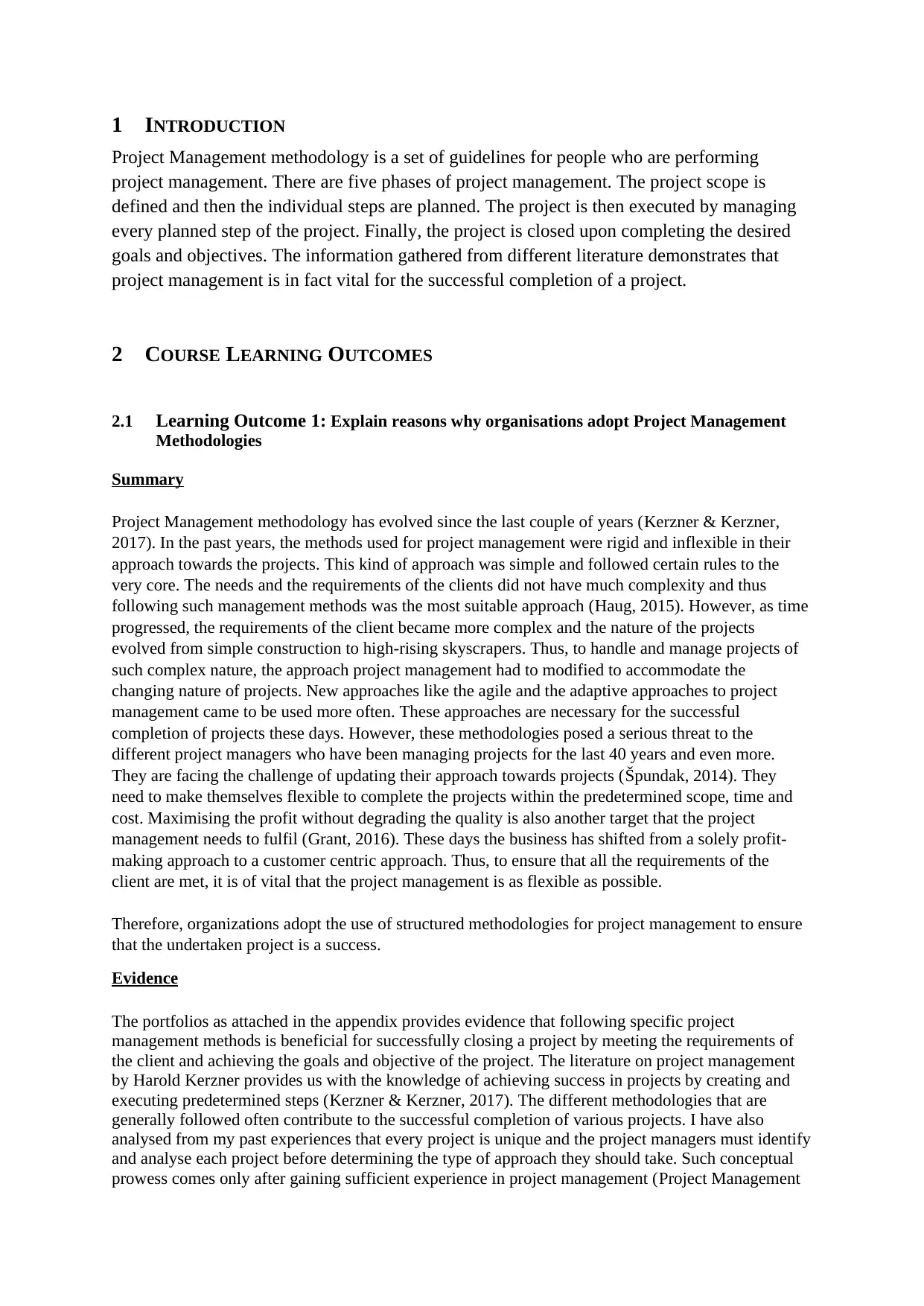
1 INTRODUCTION
Project Management methodology is a set of guidelines for people who are performing
project management. There are five phases of project management. The project scope is
defined and then the individual steps are planned. The project is then executed by managing
every planned step of the project. Finally, the project is closed upon completing the desired
goals and objectives. The information gathered from different literature demonstrates that
project management is in fact vital for the successful completion of a project.
2 COURSE LEARNING OUTCOMES
2.1 Learning Outcome 1: Explain reasons why organisations adopt Project Management
Methodologies
Summary
Project Management methodology has evolved since the last couple of years (Kerzner & Kerzner,
2017). In the past years, the methods used for project management were rigid and inflexible in their
approach towards the projects. This kind of approach was simple and followed certain rules to the
very core. The needs and the requirements of the clients did not have much complexity and thus
following such management methods was the most suitable approach (Haug, 2015). However, as time
progressed, the requirements of the client became more complex and the nature of the projects
evolved from simple construction to high-rising skyscrapers. Thus, to handle and manage projects of
such complex nature, the approach project management had to modified to accommodate the
changing nature of projects. New approaches like the agile and the adaptive approaches to project
management came to be used more often. These approaches are necessary for the successful
completion of projects these days. However, these methodologies posed a serious threat to the
different project managers who have been managing projects for the last 40 years and even more.
They are facing the challenge of updating their approach towards projects (Špundak, 2014). They
need to make themselves flexible to complete the projects within the predetermined scope, time and
cost. Maximising the profit without degrading the quality is also another target that the project
management needs to fulfil (Grant, 2016). These days the business has shifted from a solely profit-
making approach to a customer centric approach. Thus, to ensure that all the requirements of the
client are met, it is of vital that the project management is as flexible as possible.
Therefore, organizations adopt the use of structured methodologies for project management to ensure
that the undertaken project is a success.
Evidence
The portfolios as attached in the appendix provides evidence that following specific project
management methods is beneficial for successfully closing a project by meeting the requirements of
the client and achieving the goals and objective of the project. The literature on project management
by Harold Kerzner provides us with the knowledge of achieving success in projects by creating and
executing predetermined steps (Kerzner & Kerzner, 2017). The different methodologies that are
generally followed often contribute to the successful completion of various projects. I have also
analysed from my past experiences that every project is unique and the project managers must identify
and analyse each project before determining the type of approach they should take. Such conceptual
prowess comes only after gaining sufficient experience in project management (Project Management
Project Management methodology is a set of guidelines for people who are performing
project management. There are five phases of project management. The project scope is
defined and then the individual steps are planned. The project is then executed by managing
every planned step of the project. Finally, the project is closed upon completing the desired
goals and objectives. The information gathered from different literature demonstrates that
project management is in fact vital for the successful completion of a project.
2 COURSE LEARNING OUTCOMES
2.1 Learning Outcome 1: Explain reasons why organisations adopt Project Management
Methodologies
Summary
Project Management methodology has evolved since the last couple of years (Kerzner & Kerzner,
2017). In the past years, the methods used for project management were rigid and inflexible in their
approach towards the projects. This kind of approach was simple and followed certain rules to the
very core. The needs and the requirements of the clients did not have much complexity and thus
following such management methods was the most suitable approach (Haug, 2015). However, as time
progressed, the requirements of the client became more complex and the nature of the projects
evolved from simple construction to high-rising skyscrapers. Thus, to handle and manage projects of
such complex nature, the approach project management had to modified to accommodate the
changing nature of projects. New approaches like the agile and the adaptive approaches to project
management came to be used more often. These approaches are necessary for the successful
completion of projects these days. However, these methodologies posed a serious threat to the
different project managers who have been managing projects for the last 40 years and even more.
They are facing the challenge of updating their approach towards projects (Špundak, 2014). They
need to make themselves flexible to complete the projects within the predetermined scope, time and
cost. Maximising the profit without degrading the quality is also another target that the project
management needs to fulfil (Grant, 2016). These days the business has shifted from a solely profit-
making approach to a customer centric approach. Thus, to ensure that all the requirements of the
client are met, it is of vital that the project management is as flexible as possible.
Therefore, organizations adopt the use of structured methodologies for project management to ensure
that the undertaken project is a success.
Evidence
The portfolios as attached in the appendix provides evidence that following specific project
management methods is beneficial for successfully closing a project by meeting the requirements of
the client and achieving the goals and objective of the project. The literature on project management
by Harold Kerzner provides us with the knowledge of achieving success in projects by creating and
executing predetermined steps (Kerzner & Kerzner, 2017). The different methodologies that are
generally followed often contribute to the successful completion of various projects. I have also
analysed from my past experiences that every project is unique and the project managers must identify
and analyse each project before determining the type of approach they should take. Such conceptual
prowess comes only after gaining sufficient experience in project management (Project Management
⊘ This is a preview!⊘
Do you want full access?
Subscribe today to unlock all pages.

Trusted by 1+ million students worldwide
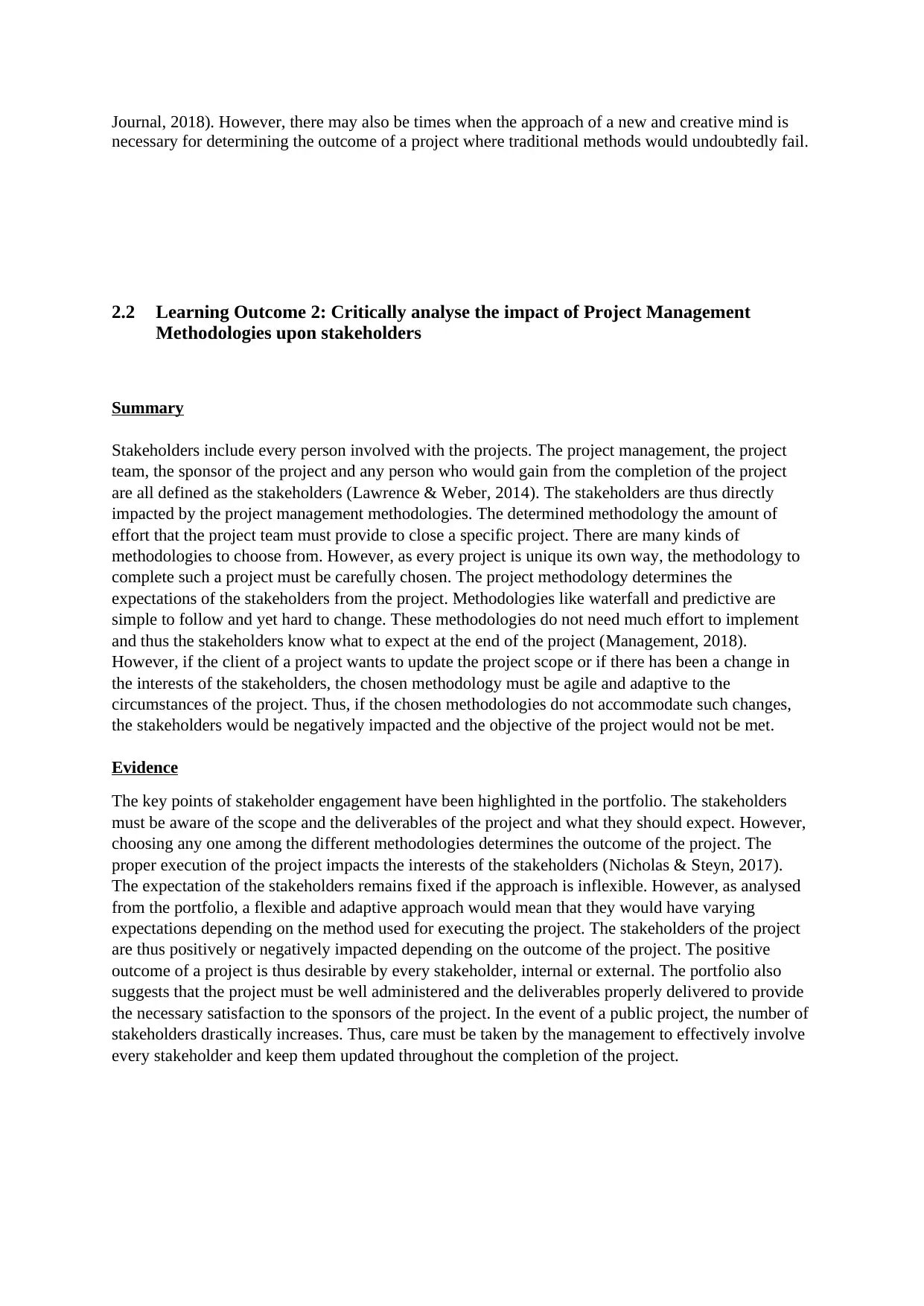
Journal, 2018). However, there may also be times when the approach of a new and creative mind is
necessary for determining the outcome of a project where traditional methods would undoubtedly fail.
2.2 Learning Outcome 2: Critically analyse the impact of Project Management
Methodologies upon stakeholders
Summary
Stakeholders include every person involved with the projects. The project management, the project
team, the sponsor of the project and any person who would gain from the completion of the project
are all defined as the stakeholders (Lawrence & Weber, 2014). The stakeholders are thus directly
impacted by the project management methodologies. The determined methodology the amount of
effort that the project team must provide to close a specific project. There are many kinds of
methodologies to choose from. However, as every project is unique its own way, the methodology to
complete such a project must be carefully chosen. The project methodology determines the
expectations of the stakeholders from the project. Methodologies like waterfall and predictive are
simple to follow and yet hard to change. These methodologies do not need much effort to implement
and thus the stakeholders know what to expect at the end of the project (Management, 2018).
However, if the client of a project wants to update the project scope or if there has been a change in
the interests of the stakeholders, the chosen methodology must be agile and adaptive to the
circumstances of the project. Thus, if the chosen methodologies do not accommodate such changes,
the stakeholders would be negatively impacted and the objective of the project would not be met.
Evidence
The key points of stakeholder engagement have been highlighted in the portfolio. The stakeholders
must be aware of the scope and the deliverables of the project and what they should expect. However,
choosing any one among the different methodologies determines the outcome of the project. The
proper execution of the project impacts the interests of the stakeholders (Nicholas & Steyn, 2017).
The expectation of the stakeholders remains fixed if the approach is inflexible. However, as analysed
from the portfolio, a flexible and adaptive approach would mean that they would have varying
expectations depending on the method used for executing the project. The stakeholders of the project
are thus positively or negatively impacted depending on the outcome of the project. The positive
outcome of a project is thus desirable by every stakeholder, internal or external. The portfolio also
suggests that the project must be well administered and the deliverables properly delivered to provide
the necessary satisfaction to the sponsors of the project. In the event of a public project, the number of
stakeholders drastically increases. Thus, care must be taken by the management to effectively involve
every stakeholder and keep them updated throughout the completion of the project.
necessary for determining the outcome of a project where traditional methods would undoubtedly fail.
2.2 Learning Outcome 2: Critically analyse the impact of Project Management
Methodologies upon stakeholders
Summary
Stakeholders include every person involved with the projects. The project management, the project
team, the sponsor of the project and any person who would gain from the completion of the project
are all defined as the stakeholders (Lawrence & Weber, 2014). The stakeholders are thus directly
impacted by the project management methodologies. The determined methodology the amount of
effort that the project team must provide to close a specific project. There are many kinds of
methodologies to choose from. However, as every project is unique its own way, the methodology to
complete such a project must be carefully chosen. The project methodology determines the
expectations of the stakeholders from the project. Methodologies like waterfall and predictive are
simple to follow and yet hard to change. These methodologies do not need much effort to implement
and thus the stakeholders know what to expect at the end of the project (Management, 2018).
However, if the client of a project wants to update the project scope or if there has been a change in
the interests of the stakeholders, the chosen methodology must be agile and adaptive to the
circumstances of the project. Thus, if the chosen methodologies do not accommodate such changes,
the stakeholders would be negatively impacted and the objective of the project would not be met.
Evidence
The key points of stakeholder engagement have been highlighted in the portfolio. The stakeholders
must be aware of the scope and the deliverables of the project and what they should expect. However,
choosing any one among the different methodologies determines the outcome of the project. The
proper execution of the project impacts the interests of the stakeholders (Nicholas & Steyn, 2017).
The expectation of the stakeholders remains fixed if the approach is inflexible. However, as analysed
from the portfolio, a flexible and adaptive approach would mean that they would have varying
expectations depending on the method used for executing the project. The stakeholders of the project
are thus positively or negatively impacted depending on the outcome of the project. The positive
outcome of a project is thus desirable by every stakeholder, internal or external. The portfolio also
suggests that the project must be well administered and the deliverables properly delivered to provide
the necessary satisfaction to the sponsors of the project. In the event of a public project, the number of
stakeholders drastically increases. Thus, care must be taken by the management to effectively involve
every stakeholder and keep them updated throughout the completion of the project.
Paraphrase This Document
Need a fresh take? Get an instant paraphrase of this document with our AI Paraphraser
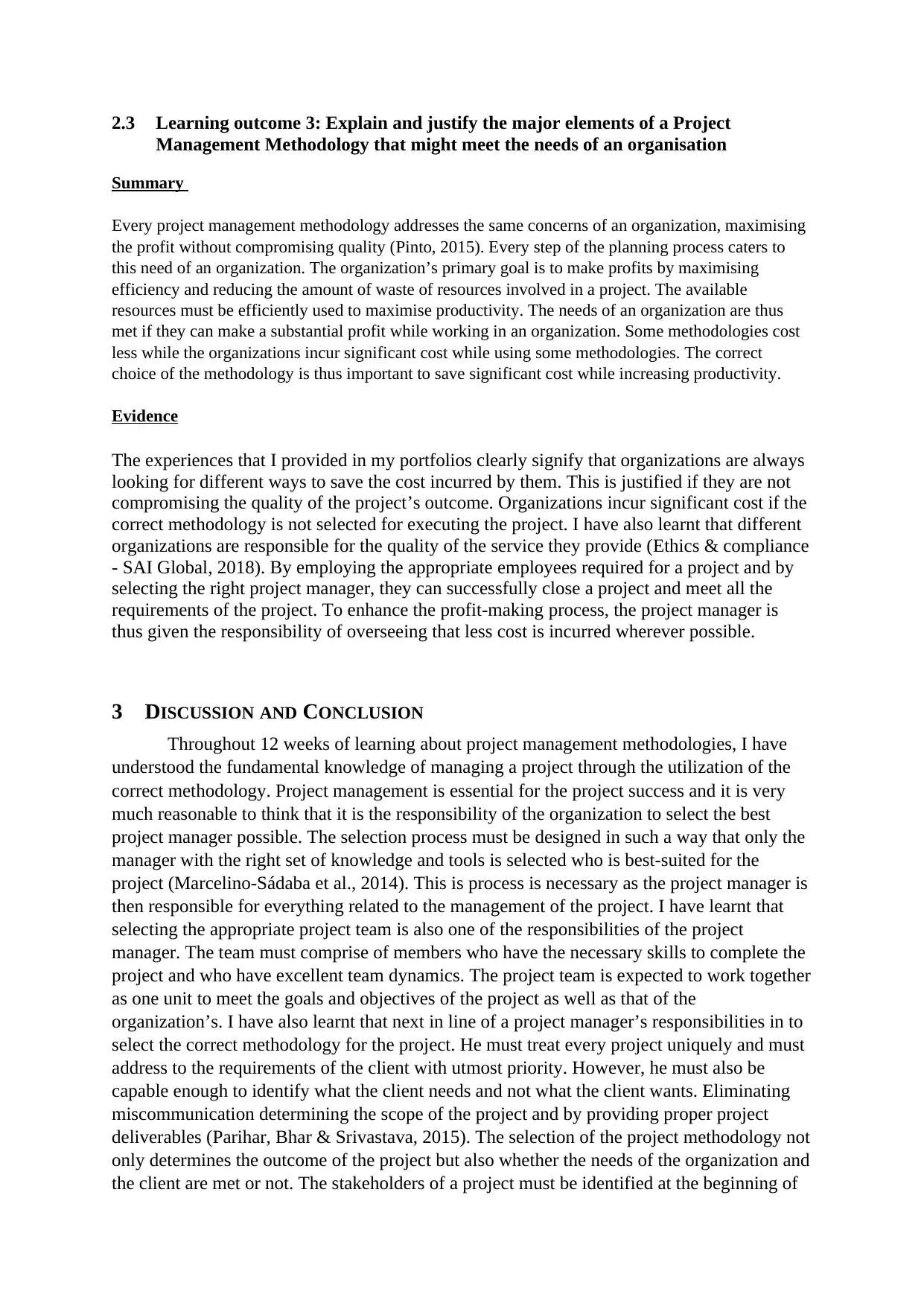
2.3 Learning outcome 3: Explain and justify the major elements of a Project
Management Methodology that might meet the needs of an organisation
Summary
Every project management methodology addresses the same concerns of an organization, maximising
the profit without compromising quality (Pinto, 2015). Every step of the planning process caters to
this need of an organization. The organization’s primary goal is to make profits by maximising
efficiency and reducing the amount of waste of resources involved in a project. The available
resources must be efficiently used to maximise productivity. The needs of an organization are thus
met if they can make a substantial profit while working in an organization. Some methodologies cost
less while the organizations incur significant cost while using some methodologies. The correct
choice of the methodology is thus important to save significant cost while increasing productivity.
Evidence
The experiences that I provided in my portfolios clearly signify that organizations are always
looking for different ways to save the cost incurred by them. This is justified if they are not
compromising the quality of the project’s outcome. Organizations incur significant cost if the
correct methodology is not selected for executing the project. I have also learnt that different
organizations are responsible for the quality of the service they provide (Ethics & compliance
- SAI Global, 2018). By employing the appropriate employees required for a project and by
selecting the right project manager, they can successfully close a project and meet all the
requirements of the project. To enhance the profit-making process, the project manager is
thus given the responsibility of overseeing that less cost is incurred wherever possible.
3 DISCUSSION AND CONCLUSION
Throughout 12 weeks of learning about project management methodologies, I have
understood the fundamental knowledge of managing a project through the utilization of the
correct methodology. Project management is essential for the project success and it is very
much reasonable to think that it is the responsibility of the organization to select the best
project manager possible. The selection process must be designed in such a way that only the
manager with the right set of knowledge and tools is selected who is best-suited for the
project (Marcelino-Sádaba et al., 2014). This is process is necessary as the project manager is
then responsible for everything related to the management of the project. I have learnt that
selecting the appropriate project team is also one of the responsibilities of the project
manager. The team must comprise of members who have the necessary skills to complete the
project and who have excellent team dynamics. The project team is expected to work together
as one unit to meet the goals and objectives of the project as well as that of the
organization’s. I have also learnt that next in line of a project manager’s responsibilities in to
select the correct methodology for the project. He must treat every project uniquely and must
address to the requirements of the client with utmost priority. However, he must also be
capable enough to identify what the client needs and not what the client wants. Eliminating
miscommunication determining the scope of the project and by providing proper project
deliverables (Parihar, Bhar & Srivastava, 2015). The selection of the project methodology not
only determines the outcome of the project but also whether the needs of the organization and
the client are met or not. The stakeholders of a project must be identified at the beginning of
Management Methodology that might meet the needs of an organisation
Summary
Every project management methodology addresses the same concerns of an organization, maximising
the profit without compromising quality (Pinto, 2015). Every step of the planning process caters to
this need of an organization. The organization’s primary goal is to make profits by maximising
efficiency and reducing the amount of waste of resources involved in a project. The available
resources must be efficiently used to maximise productivity. The needs of an organization are thus
met if they can make a substantial profit while working in an organization. Some methodologies cost
less while the organizations incur significant cost while using some methodologies. The correct
choice of the methodology is thus important to save significant cost while increasing productivity.
Evidence
The experiences that I provided in my portfolios clearly signify that organizations are always
looking for different ways to save the cost incurred by them. This is justified if they are not
compromising the quality of the project’s outcome. Organizations incur significant cost if the
correct methodology is not selected for executing the project. I have also learnt that different
organizations are responsible for the quality of the service they provide (Ethics & compliance
- SAI Global, 2018). By employing the appropriate employees required for a project and by
selecting the right project manager, they can successfully close a project and meet all the
requirements of the project. To enhance the profit-making process, the project manager is
thus given the responsibility of overseeing that less cost is incurred wherever possible.
3 DISCUSSION AND CONCLUSION
Throughout 12 weeks of learning about project management methodologies, I have
understood the fundamental knowledge of managing a project through the utilization of the
correct methodology. Project management is essential for the project success and it is very
much reasonable to think that it is the responsibility of the organization to select the best
project manager possible. The selection process must be designed in such a way that only the
manager with the right set of knowledge and tools is selected who is best-suited for the
project (Marcelino-Sádaba et al., 2014). This is process is necessary as the project manager is
then responsible for everything related to the management of the project. I have learnt that
selecting the appropriate project team is also one of the responsibilities of the project
manager. The team must comprise of members who have the necessary skills to complete the
project and who have excellent team dynamics. The project team is expected to work together
as one unit to meet the goals and objectives of the project as well as that of the
organization’s. I have also learnt that next in line of a project manager’s responsibilities in to
select the correct methodology for the project. He must treat every project uniquely and must
address to the requirements of the client with utmost priority. However, he must also be
capable enough to identify what the client needs and not what the client wants. Eliminating
miscommunication determining the scope of the project and by providing proper project
deliverables (Parihar, Bhar & Srivastava, 2015). The selection of the project methodology not
only determines the outcome of the project but also whether the needs of the organization and
the client are met or not. The stakeholders of a project must be identified at the beginning of
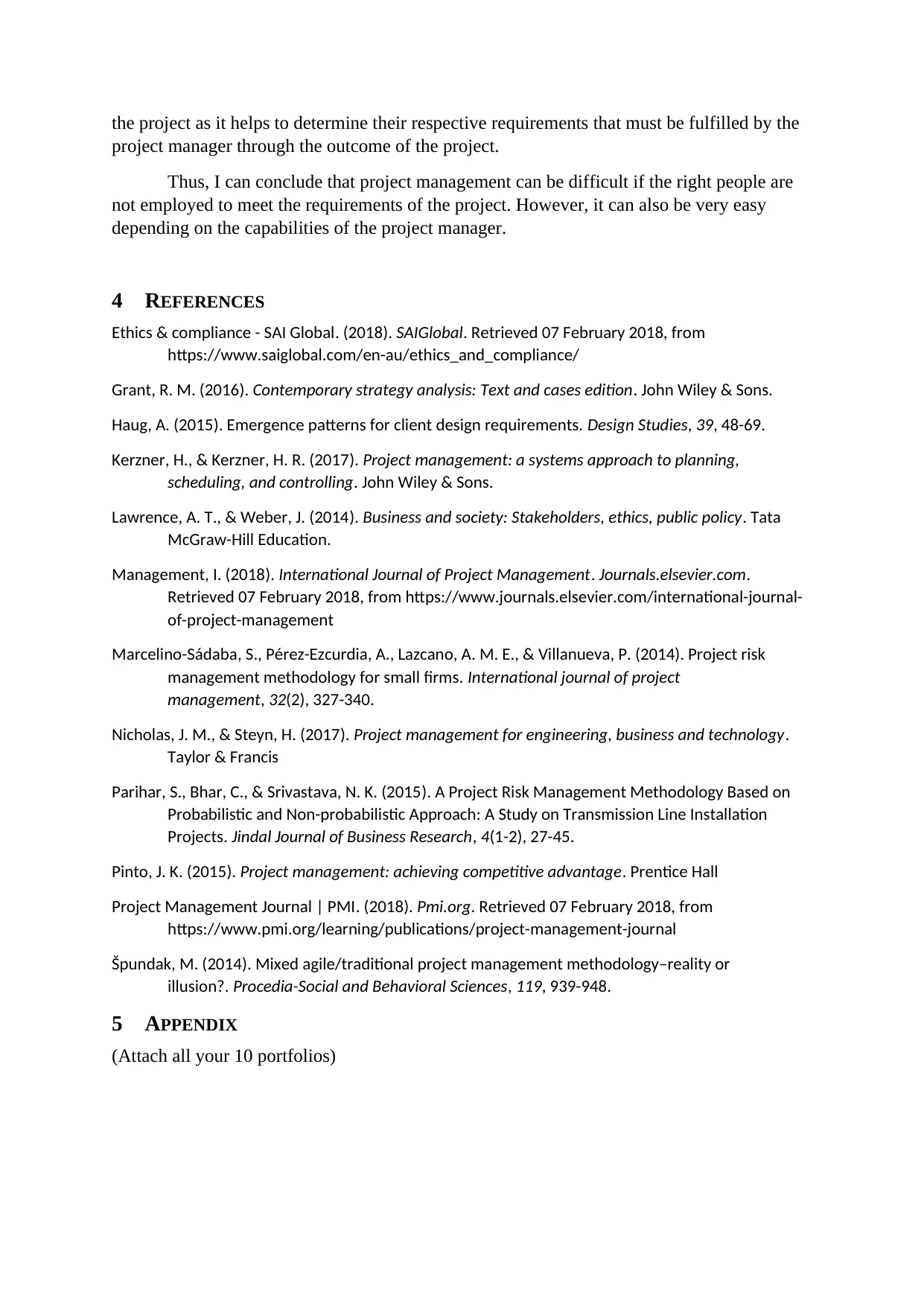
the project as it helps to determine their respective requirements that must be fulfilled by the
project manager through the outcome of the project.
Thus, I can conclude that project management can be difficult if the right people are
not employed to meet the requirements of the project. However, it can also be very easy
depending on the capabilities of the project manager.
4 REFERENCES
Ethics & compliance - SAI Global. (2018). SAIGlobal. Retrieved 07 February 2018, from
https://www.saiglobal.com/en-au/ethics_and_compliance/
Grant, R. M. (2016). Contemporary strategy analysis: Text and cases edition. John Wiley & Sons.
Haug, A. (2015). Emergence patterns for client design requirements. Design Studies, 39, 48-69.
Kerzner, H., & Kerzner, H. R. (2017). Project management: a systems approach to planning,
scheduling, and controlling. John Wiley & Sons.
Lawrence, A. T., & Weber, J. (2014). Business and society: Stakeholders, ethics, public policy. Tata
McGraw-Hill Education.
Management, I. (2018). International Journal of Project Management. Journals.elsevier.com.
Retrieved 07 February 2018, from https://www.journals.elsevier.com/international-journal-
of-project-management
Marcelino-Sádaba, S., Pérez-Ezcurdia, A., Lazcano, A. M. E., & Villanueva, P. (2014). Project risk
management methodology for small firms. International journal of project
management, 32(2), 327-340.
Nicholas, J. M., & Steyn, H. (2017). Project management for engineering, business and technology.
Taylor & Francis
Parihar, S., Bhar, C., & Srivastava, N. K. (2015). A Project Risk Management Methodology Based on
Probabilistic and Non-probabilistic Approach: A Study on Transmission Line Installation
Projects. Jindal Journal of Business Research, 4(1-2), 27-45.
Pinto, J. K. (2015). Project management: achieving competitive advantage. Prentice Hall
Project Management Journal | PMI. (2018). Pmi.org. Retrieved 07 February 2018, from
https://www.pmi.org/learning/publications/project-management-journal
Špundak, M. (2014). Mixed agile/traditional project management methodology–reality or
illusion?. Procedia-Social and Behavioral Sciences, 119, 939-948.
5 APPENDIX
(Attach all your 10 portfolios)
project manager through the outcome of the project.
Thus, I can conclude that project management can be difficult if the right people are
not employed to meet the requirements of the project. However, it can also be very easy
depending on the capabilities of the project manager.
4 REFERENCES
Ethics & compliance - SAI Global. (2018). SAIGlobal. Retrieved 07 February 2018, from
https://www.saiglobal.com/en-au/ethics_and_compliance/
Grant, R. M. (2016). Contemporary strategy analysis: Text and cases edition. John Wiley & Sons.
Haug, A. (2015). Emergence patterns for client design requirements. Design Studies, 39, 48-69.
Kerzner, H., & Kerzner, H. R. (2017). Project management: a systems approach to planning,
scheduling, and controlling. John Wiley & Sons.
Lawrence, A. T., & Weber, J. (2014). Business and society: Stakeholders, ethics, public policy. Tata
McGraw-Hill Education.
Management, I. (2018). International Journal of Project Management. Journals.elsevier.com.
Retrieved 07 February 2018, from https://www.journals.elsevier.com/international-journal-
of-project-management
Marcelino-Sádaba, S., Pérez-Ezcurdia, A., Lazcano, A. M. E., & Villanueva, P. (2014). Project risk
management methodology for small firms. International journal of project
management, 32(2), 327-340.
Nicholas, J. M., & Steyn, H. (2017). Project management for engineering, business and technology.
Taylor & Francis
Parihar, S., Bhar, C., & Srivastava, N. K. (2015). A Project Risk Management Methodology Based on
Probabilistic and Non-probabilistic Approach: A Study on Transmission Line Installation
Projects. Jindal Journal of Business Research, 4(1-2), 27-45.
Pinto, J. K. (2015). Project management: achieving competitive advantage. Prentice Hall
Project Management Journal | PMI. (2018). Pmi.org. Retrieved 07 February 2018, from
https://www.pmi.org/learning/publications/project-management-journal
Špundak, M. (2014). Mixed agile/traditional project management methodology–reality or
illusion?. Procedia-Social and Behavioral Sciences, 119, 939-948.
5 APPENDIX
(Attach all your 10 portfolios)
⊘ This is a preview!⊘
Do you want full access?
Subscribe today to unlock all pages.

Trusted by 1+ million students worldwide
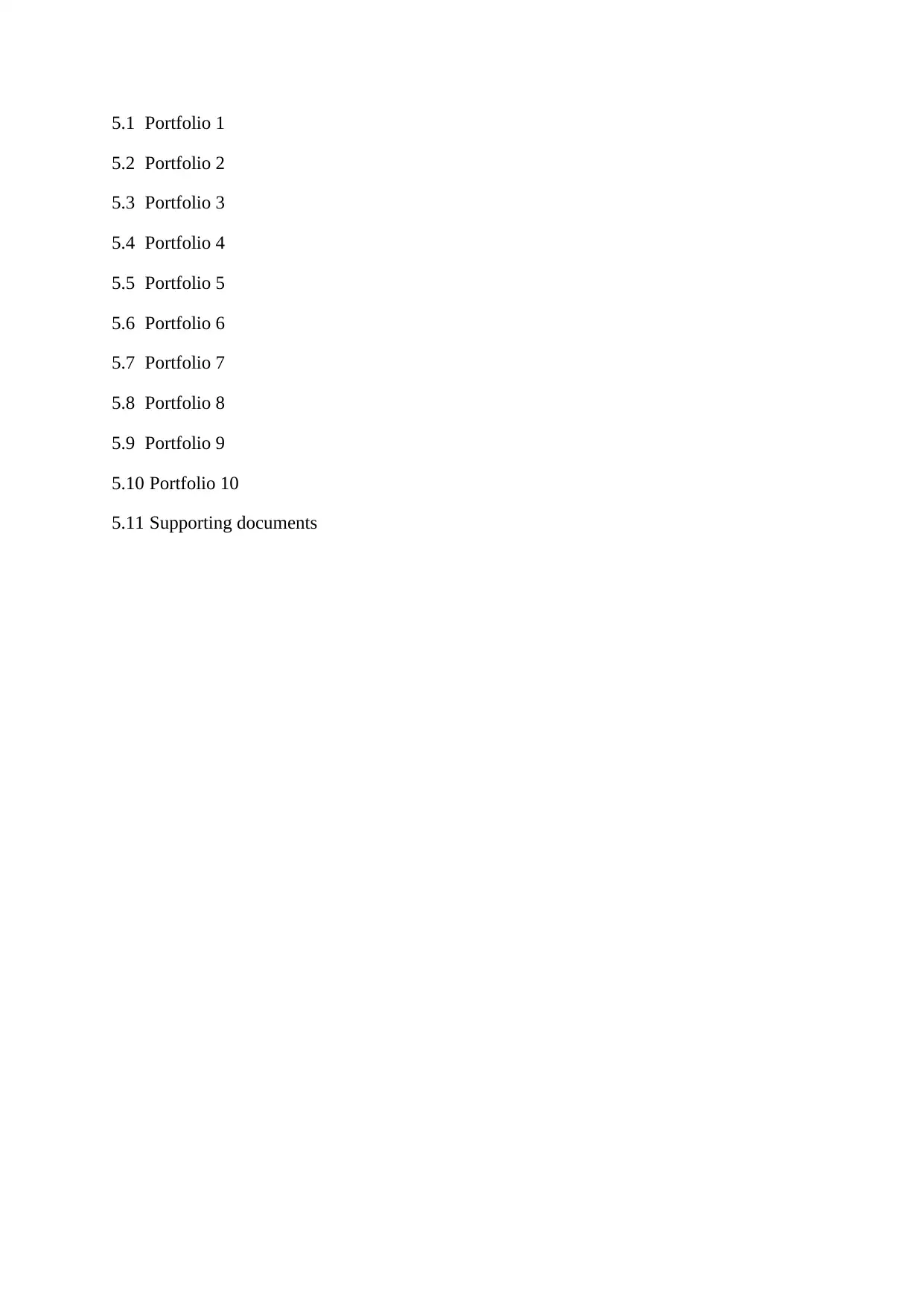
5.1 Portfolio 1
5.2 Portfolio 2
5.3 Portfolio 3
5.4 Portfolio 4
5.5 Portfolio 5
5.6 Portfolio 6
5.7 Portfolio 7
5.8 Portfolio 8
5.9 Portfolio 9
5.10 Portfolio 10
5.11 Supporting documents
5.2 Portfolio 2
5.3 Portfolio 3
5.4 Portfolio 4
5.5 Portfolio 5
5.6 Portfolio 6
5.7 Portfolio 7
5.8 Portfolio 8
5.9 Portfolio 9
5.10 Portfolio 10
5.11 Supporting documents
1 out of 7
Related Documents
Your All-in-One AI-Powered Toolkit for Academic Success.
+13062052269
info@desklib.com
Available 24*7 on WhatsApp / Email
![[object Object]](/_next/static/media/star-bottom.7253800d.svg)
Unlock your academic potential
Copyright © 2020–2025 A2Z Services. All Rights Reserved. Developed and managed by ZUCOL.


